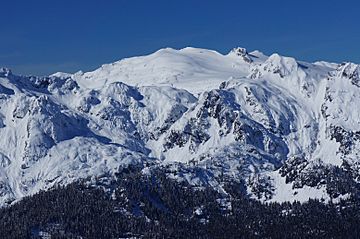Bacon Peak facts for kids
Quick facts for kids Bacon Peak |
|
|---|---|

Bacon Peak in winter seen from Oakes Peak
|
|
| Highest point | |
| Elevation | 7,070 ft (2,155 m) NAVD 88 |
| Prominence | 2,505 ft (764 m) |
| Geography | |
| Parent range | North Cascades |
| Topo map | USGS Bacon Peak |
| Climbing | |
| First ascent | R.B. Robertson, Eugene Logan (1905, possibly) |
Bacon Peak is a cool mountain found in North Cascades National Park in Washington State. It's part of the big Cascade Range of mountains. This mountain has several glaciers, which are like giant, slow-moving rivers of ice. Together, they cover about 1.2 square miles (3.2 km2). The three main ones are the Diobsud Creek Glacier on the southeast side (about 1.6 miles (2.5 km) wide), the Green Lake Glacier on the northeast (about 1.3 miles (2.1 km) wide), and the Noisy Creek Glacier on the northwest (about 0.9 miles (1.4 km) long).
Weather at Bacon Peak
Bacon Peak is in a place with a special kind of weather called a marine west coast climate. This means it's near the ocean in western North America. Most of the weather systems start over the Pacific Ocean. They then travel northeast towards the Cascade Mountains.
When these weather systems hit the tall Cascade Mountains, they are forced to rise. As they go up, they drop their moisture as rain or snow onto the mountains. This is called orographic lift. Because of this, the western side of the North Cascades gets a lot of rain and snow, especially in winter.
In winter, the weather is often cloudy. But in summer, high pressure systems over the Pacific Ocean usually bring clear skies. Since the ocean influences the weather, the snow here tends to be wet and heavy. This can make avalanches more likely, so it's important to be careful.
How the Mountains Formed
The North Cascades area has some really rugged land. You can see sharp peaks, tall spires, long ridges, and deep valleys carved by glaciers. These amazing shapes and big changes in height were created by geological events that happened millions of years ago. These events also led to the different climates we see across the Cascade Range.
The story of how the Cascade Mountains formed goes back millions of years. It started in the late Eocene Epoch. At that time, the North American Plate (a huge piece of Earth's crust) was slowly moving over the Pacific Plate. This movement caused a lot of volcanic activity.
Also, small pieces of Earth's crust, called terranes, crashed into the North American continent. These pieces helped build the North Cascades about 50 million years ago.
Later, during the Pleistocene period (which began over two million years ago), huge sheets of ice called glaciers moved across the land. They advanced and then melted back many times. As they moved, they scraped and shaped the landscape, leaving behind piles of rock. The river valleys in this area often have a "U" shape. This shape is a clear sign that glaciers carved them out.
The combination of the land pushing up (called uplift), cracks in the Earth's crust (called faulting), and the powerful glaciers has created the tall peaks and deep valleys you see in the North Cascades today.
Mountains Nearby
- Electric Butte
- Mount Watson
- Logger Butte
- Canadian Bacon
- Mount Despair



